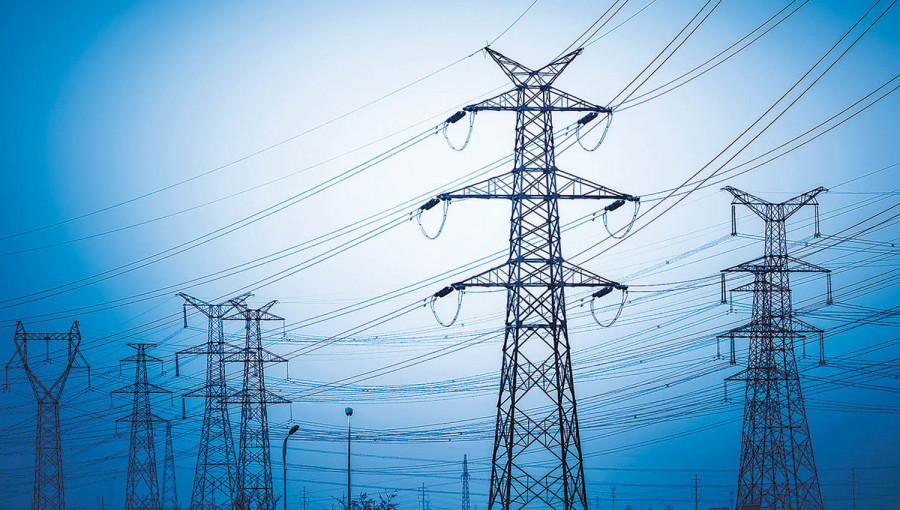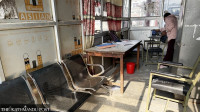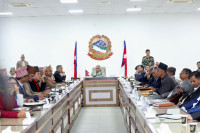National
Nepal, Bangladesh to discuss two options for dedicated cross–border transmission lines
India’s approval will be crucial for viability of any connectivity between the two countries.
Prithvi Man Shrestha
As Nepal and Bangladesh have already requested India to allow them to use the existing Indian transmission line infrastructure to supply 40–50 megawatts of Nepal’s power to Bangladesh, they also want a dedicated transmission line through the Indian territory.
The two countries have identified two routes for a dedicated transmission line via India on which the two countries will discuss during the two-day fifth joint-secretary-level Joint Working Group and secretary-level Joint Steering Committee meetings scheduled to start on Monday in Bangladesh.
“There will be discussion on constructing a dedicated transmission line over the Indian territory,” said Madhu Bhetuwal, spokesperson for the Ministry of Energy, Water Resources and Irrigation who is also a member of the Nepali delegation.
“The two countries will discuss ways to take India on board regarding the dedicated power line along with using India's existing power line for power trade.”
Nepal and Bangladesh have already identified two potential routes for the power infrastructure.
One is Anarmari (Nepal) to Panchagarh (Bangladesh) whose total length will be 49km. If the transmission line is constructed, 24km Indian territory should be used, Power Grid Company of Bangladesh Limited stated in a presentation.
Another proposed route is Anarmari (Nepal) to Thakurgaon (Bangladesh) whose length will be 83km. In order to construct the transmission line along this alignment, 33km of Indian territory should be used.
“These routes were identified by the joint technical team of two countries,” said Dirghayu Kumar Shrestha, chief of transmission directorate at Nepal Electricity Authority (NEA).
According to the NEA, there is a 132kV substation at the Anarmani area of Jhapa. Because of low capacity substation, it cannot support transmission of more than 150MW electricity, it said.
The state-owned utility plans to extend the under-construction 400kV Hetauda-Bardibas-Inaruwa Transmission Line to Anarmani. The NEA has conducted a survey to finalise the route for extending the 400kV transmission line from Inaruwa to Anarmani with the support of the World Bank.
“Even though there has been discussion on constructing a dedicated transmission line, no conclusion has been drawn regarding its modality,” said Shrestha.
Besides dedicated transmission lines, Nepal sees the prospect of increasing the capacity of existing transmission infrastructure enabling increased power trade between Nepal and Bangladesh through India.
During the fourth JWC and JSC meeting held in August last year in Kathmandu, Nepal and Bangladesh had decided to request the southern neighbour to allow the export of 40 to 50 megawatts of electricity from Nepal to Bangladesh in the initial phase by utilising the high-voltage Baharampur-Bheramara cross-border transmission link.
“We have known that the Bangladesh substation has two blocks with a capacity of 500MW each,” said Shrestha of the NEA. “But the capacity of the transmission line is 3000MW. So, by adding the capacity of the substation, there is the possibility of boosting power trading through this existing transmission line too.”
Initially, Nepal and Bangladesh want the export of 40MW-50MW electricity from Nepal through the Baharampur-Bheramara line.
As per last year’s understanding, the NEA and the Bangladesh Power Development Board would request India’s NTPC Vidyut Vyapar Nigam for a trilateral energy sales and purchase agreement, utilising the power line. According to the agreement reached with Bangladesh, the NEA has sent a request to the Indian authorities through the NTPC Vidyut Vyapar Nigam, a nodal agency for bilateral electricity trade.
During the 10th joint secretary-level Joint Working Group and the secretary-level Joint Steering Committee between Nepal and India held in February this year, India agreed to grant its approval once Nepal submits the proposal along with the project whose power will be sold to Bangladesh, according to Nepal’s energy ministry.
Based on an understanding reached between Nepal and India, the NEA has sent a request to the Indian authorities to allow the power generated by the 52.4MW Likhu-4 project to Bangladesh through India’s existing transmission infrastructure.
As Nepal and Bangladesh are discussing transmission connectivity, Nepal and India agreed to study the feasibility of constructing a cross-border transmission line between Nepal and West Bengal last year.
During the ninth meetings of the joint secretary-level Joint Working Group and secretary-level Joint Steering Committee on bilateral power sector cooperation between Nepal and India last year, they agreed to authorise the existing Joint Technical Team to conduct the study.
Nepali officials have said that though the connectivity planned with the West Bengal state was for bilateral electricity trading, it could help establish connectivity with Bangladesh through West Bengal.




 19.12°C Kathmandu
19.12°C Kathmandu















